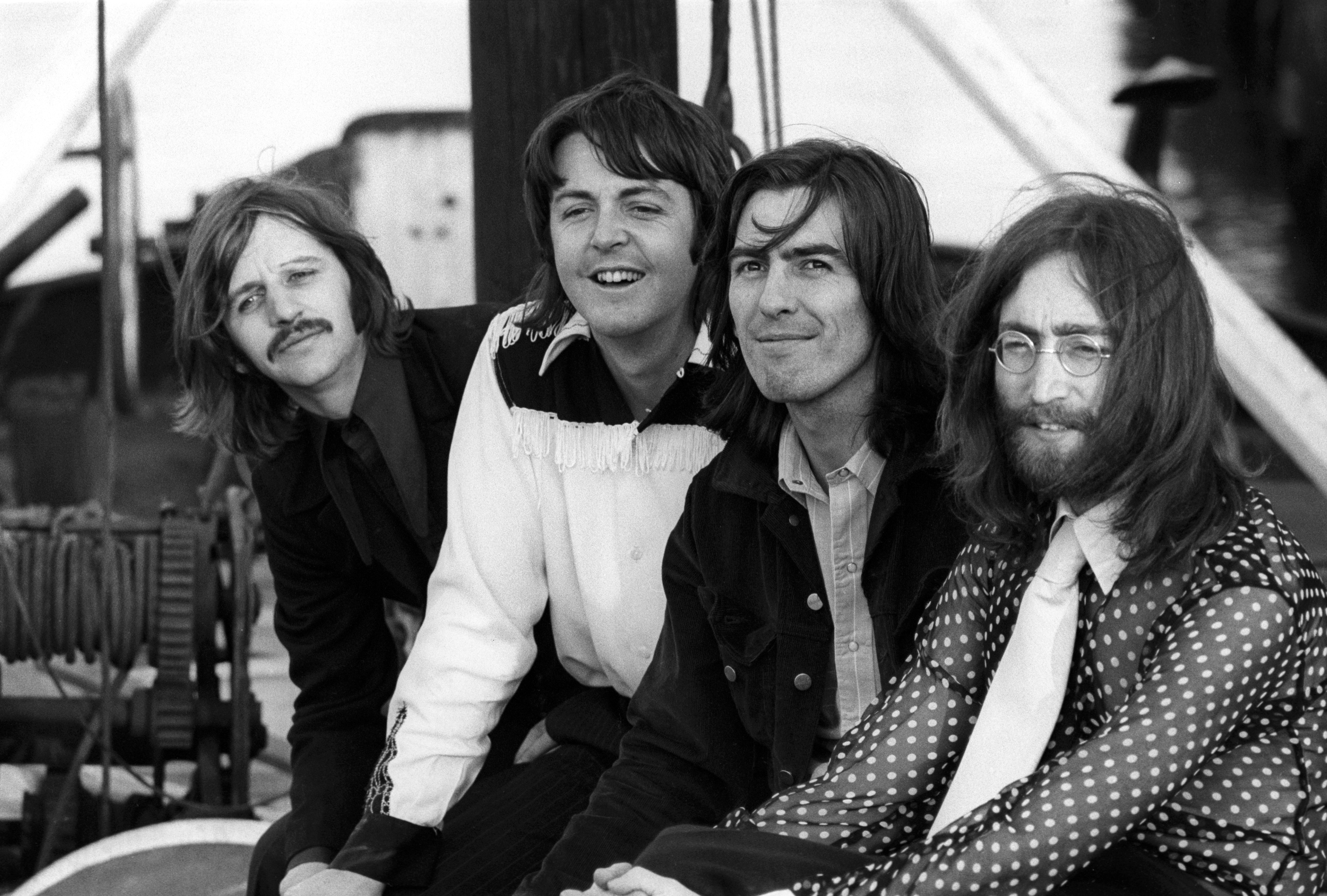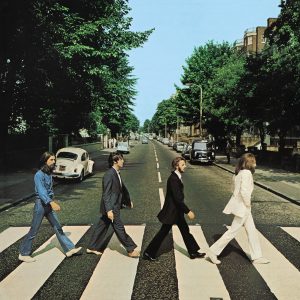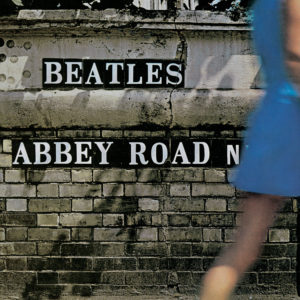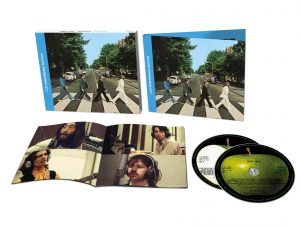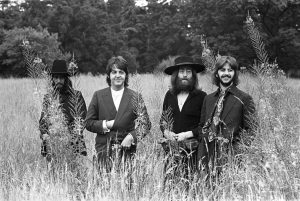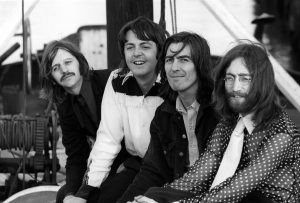Abbey Road Presented with New Mixes in Stereo, 5.1 Surround, and Dolby Atmos; Expanded with Previously Unreleased Session Recordings and Demos
By Harvey Kubernik © 2019
It was 50 years ago today, on August 8, 1969, that the world’s most famous band stepped out from London’s EMI Recording Studios to
stride, single-file, across the black and white stripes of Abbey Road’s nearby zebra crossing. With photographer Iain Macmillan balanced on a stepladder and one policeman stopping the street’s light traffic, The Beatles crossed back and forth three times, led by John Lennon, followed by Ringo Starr, Paul McCartney, and George Harrison. Just six photos were taken, with the fifth selected as the cover shot for The Beatles’ penultimate studio album, Abbey Road, named after the tree-lined street in which the studios are located.
Released September 26, 1969, Abbey Road was not The Beatles’ final album, as Let It Be followed in 1970, but it was the last one John, Paul, George, and Ringo recorded together as a band. The Beatles will celebrate Abbey Road’s anniversary with a suite of beautifully presented packages to be released worldwide on September 27 by Apple Corps Ltd./Capitol/UMe. the album’s 17 tracks are newly mixed by producer Giles Martin and mix engineer Sam Okell in stereo, high res stereo, 5.1 surround, and Dolby Atmos, accompanied by 23 session recordings and demos, most of which are previously unreleased.
This is the first time Abbey Road has been remixed and presented with additional session recordings and demos. The album’s sweeping new edition follows the universally acclaimed remixed and expanded anniversary editions of Sgt. Pepper’s Lonely Hearts Club Band and The BEATLES (‘White Album’) released in 2017 and 2018, respectively. To create Abbey Road’s new stereo, 5.1 surround, and Dolby Atmos mixes, Martin and Okell worked with an expert team of engineers and audio restoration specialists at Abbey Road Studios. All the new Abbey Road releases feature the new stereo album mix, sourced directly from the original eight-track session tapes. To produce the mix, Giles was guided by the album’s original stereo mix supervised by his father, George Martin.
Abbey Road’s Super Deluxe box set presents 40 tracks – including “The Long One” Trial Edit & Mix for the album’s epic Side 2 medley – on three CDs (stereo) and one Blu-ray disc (Dolby Atmos, 96kHz/24 bit high resolution stereo, and 96 kHz/24 bit DTS-HD Master Audio 5.1). The four discs are housed in a slip-sleeved 12” by 12” 100-page hardbound book with McCartney’s foreword; Martin’s introduction; insightful, in-depth chapters written by Beatles historian, author, and radio producer Kevin Howlett covering the months preceding The Beatles’ Abbey Road sessions, track-by-track details and session notes, the cover art and photo shoot, and the album’s reception upon its release; plus an essay by music journalist and author David Hepworth looking at the album’s influence through 50 years.
The book is illustrated with rare and previously unpublished photographs, including many taken by Linda McCartney; never before published images of handwritten lyrics, sketches, and a George Martin score; Beatles correspondence, recording sheets, and tape boxes; and reproduced original print ads. The Super Deluxe digital audio collection presents all 40 tracks for download purchase and streaming in standard and MFiT formats, as well as in high resolution audio (96kHz/24 bit) for download.
Abbey Road’s limited edition Deluxe vinyl box set features all 40 tracks from the Super Deluxe collection on three 180-gram vinyl LPs. The album’s new stereo mix LP is packaged in a faithfully replicated sleeve, with the two Sessions LPs paired in their own jacket, presented with a four-page insert in a lift-top box. The Deluxe 2CD set pairs the new stereo mix with versions taken from the session takes and demo recordings of its 17 songs, sequenced to match the album’s running order.
The two discs are presented in a digipak with a 40-page booklet abridged from the Super Deluxe book. The album’s new stereo mix is also available in 1CD and 180-gram 1LP vinyl packages, for digital download in standard and MFiT audio, and on a limited edition picture disc vinyl LP illustrated by the album’s front and back cover art images.
Abbey Road’s Super Deluxe and Deluxe vinyl box sets’ 23 session and demo recordings are presented in chronological order of their first recording dates. “I Want You (She’s So Heavy)” leads the charge:
A few weeks before Abbey Road’s release on September 26, 1969, Apple’s press officer Derek Taylor revealed that the album was “recorded at nice, workmanlike sessions which usually began at 2pm and continued until the end of the evening.” Millions of Abbey Road LPs were pressed at manufacturing plants around the world.
The album was another blockbuster release for The Beatles, holding the No. 1 spot on the U.K. albums chart for a total of 17 weeks and topping Billboard’s U.S. albums chart for 11weeks. For their work on Abbey Road, Geoff Emerick and Phil McDonald won the year’s GRAMMY Award® for Best Engineered Recording, Non-Classical. In 1995, Abbey Road was inducted into the Recording Academy’s GRAMMY Hall of Fame, recognizing “recordings of lasting qualitative or historical significance.” The Beatles’ best-selling studio album, Abbey Road’s universal popularity and influence have continued to grow since its debut.
Since Abbey Road’s release, the street’s zebra crossing has been one of the most celebrated and photographed sites in the world protected as an historic landmark and visited by thousands of Beatles fans each year. Due to the success of The Beatles’ album, EMI Recording Studios was renamed Abbey Road Studios. Owned and operated by Universal Music Group, Abbey Road Studios is the most famous recording studio in the world and a global music icon.
Abbey Road Anniversary Edition
Tracklists
SUPER DELUXE [3CD+1Blu-ray set; digital audio collection]
CD ONE: 2019 Stereo Mix
- Come Together
- Something
- Maxwell’s Silver Hammer
- Oh! Darling
- Octopus’s Garden
- I Want You (She’s So Heavy)
- Here Comes The Sun
- Because
- You Never Give Me Your Money
- Sun King
- Mean Mr Mustard
- Polythene Pam
- She Came In Through The Bathroom Window
- Golden Slumbers
- Carry That Weight
- The End
- Her Majesty
CD TWO: Sessions
- I Want You (She’s So Heavy) (Trident Recording Session & Reduction Mix)
- Goodbye (Home Demo)
- Something (Studio Demo)
- The Ballad Of John And Yoko (Take 7)
- Old Brown Shoe (Take 2)
- Oh! Darling (Take 4)
- Octopus’s Garden (Take 9)
- You Never Give Me Your Money (Take 36)
- Her Majesty (Takes 1–3)
- Golden Slumbers/Carry That Weight (Takes 1–3 / Medley)
- Here Comes The Sun (Take 9)
- Maxwell’s Silver Hammer (Take 12)
CD THREE: Sessions
- Come Together (Take 5)
- The End (Take 3)
- Come And Get It (Studio Demo)
- Sun King (Take 20)
- Mean Mr Mustard (Take 20)
- Polythene Pam (Take 27)
- She Came In Through The Bathroom Window (Take 27)
- Because (Take 1 – Instrumental)
- The Long One (Trial Edit & Mix – 30 July 1969)
(Medley: You Never Give Me Your Money, Sun King, Mean Mr Mustard, Her Majesty, Polythene Pam, She Came In Through The Bathroom Window, Golden Slumbers, Carry That Weight, The End)
- Something (Take 39 – Instrumental – Strings Only)
- Golden Slumbers/Carry That Weight (Take 17 – Instrumental – Strings & Brass Only)
BLU-RAY: Abbey Road
Audio Features:
– Dolby Atmos
– 96kHz/24 bit DTS-HD Master Audio 5.1
– 96kHz/24 bit High Res Stereo (2019 Stereo Mix)
DELUXE 3LP VINYL BOX SET (limited edition)
LP ONE: Side 1 (2019 Stereo Mix)
- Come Together
- Something
- Maxwell’s Silver Hammer
- Oh! Darling
- Octopus’s Garden
- I Want You (She’s So Heavy)
LP ONE: Side 2 (2019 Stereo Mix)
- Here Comes The Sun
- Because
- You Never Give Me Your Money
- Sun King
- Mean Mr Mustard
- Polythene Pam
- She Came In Through The Bathroom Window
- Golden Slumbers
- Carry That Weight
- The End
- Her Majesty
LP TWO: Side 1 (Sessions)
- I Want You (She’s So Heavy) (Trident Recording Session and Reduction Mix)
- Goodbye (Home Demo)
- Something (Studio Demo)
- The Ballad Of John And Yoko (Take 7)
- Old Brown Shoe (Take 2)
LP TWO: Side 2 (Sessions)
- Oh! Darling (Take 4)
- Octopus’s Garden (Take 9)
- You Never Give Me Your Money (Take 36)
- Her Majesty (Takes 1–3)
- Golden Slumbers/Carry That Weight (Takes 1–3) / Medley)
- Here Comes The Sun (Take 9)
- Maxwell’s Silver Hammer (Take 12)
LP THREE: Side 1 (Sessions)
- Come Together (Take 5)
- The End (Take 3)
- Come and Get It (Studio Demo)
- Sun King (Take 20)
- Mean Mr Mustard (Take 20)
- Polythene Pam (Take 27)
- She Came In Through The Bathroom Window (Take 27)
- Because (Take 1 Instrumental)
LP THREE: Side 2 (Sessions)
- The Long One (Trial Edit & Mix – 30 July 1969)
- Something (Take 39 – Instrumental – Strings Only)
- Golden Slumbers/Carry That Weight (Take 17 – Instrumental – Strings & Brass Only)
DELUXE 2CD
CD ONE: 2019 Stereo Mix
CD TWO: Sessions
- Come Together (Take 5)
- Something (Studio Demo)
- Maxwell’s Silver Hammer (Take 12)
- Oh! Darling (Take 4)
- Octopus’s Garden (Take 9)
- I Want You (She’s So Heavy) (Trident Recording Session & Reduction Mix)
- Here Comes The Sun (Take 9)
- Because (Take 1 Instrumental)
- You Never Give Me Your Money (Take 36)
- Sun King (Take 20)
- Mean Mr Mustard (Take 20)
- Polythene Pam (Take 27)
- She Came In Through The Bathroom Window (Take 27)
- Golden Slumbers/Carry That Weight (Takes 1–3 / Medley)
- The End (Take 3)
- Her Majesty (Takes 1–3)
STANDARD [1CD; digital; 1LP vinyl; limited edition 1LP picture disc vinyl]
2019 Stereo Mix
We’ve all heard and been profoundly inspired by the work of engineer Geoff Emerick. From Revolver on he was the full-time recording and remix engineer under George Martin. “Tomorrow Never Knows” was his first Beatles session. Geoff was behind the console until midway through the recording of the Beatles’ White Album. He later returned to helm Abbey Road.
Emerick is, with Howard Massey, the author of Here, There and Everywhere: My Life Recording the Music of the Beatles.
“I hear music in colors,” Emerick explained to me earlier this century in Hollywood at Capitol Records Studio B. “Bass and drums are always my favorite,” stressed Geoff. “And just building stuff around that, from color textures in my head, based upon what’s happening in the studio.”
Geoff’s drum and bass sounds have motivated generations of musicians. His recording techniques and innovations include automatic double-tracking; backwards guitar solo and loops, and real-time varispeed manipulation that infused John Lennon’s signature vocal echo.
“I had the wonderful opportunity of recording The Hollies at Abbey Road Studio Two while Beatles era EMI Chief Technical Engineer Ken Townsend was the then Studio Manager,” reminisced record producer and engineer, Richard Bosworth, who offered some remarkable insights into sonic aspects of Abbey Road.
“He made a point of hanging out at the sessions as The Hollies were longtime friends and co-workers recording a string of hit singles and albums going back to 1964. Townsend was gracious and forthcoming explaining to me how he had designed ADT(automatic double tracking) tape flanging and STEED(send tape echo echo delay). Although familiar with these techniques and the mechanics of them it was extraordinary to have the actual inventor excitedly tell me his very personal story how it all came to pass.
“Several years later I attended for the second time one of Phil Spector’s annual birthday parties held for his daughter at a bowling alley/snack bar in Montrose California. There were always significant record making people at these functions, musicians, recording engineers, etc., some from Spector’s own iconic productions.
“That year Harvey Kubernik introduced me to the quiet unassuming Geoff Emerick. Mentioning that I had been trained as a Producer/Engineer by Val Garay whose work Emerick was aware of and admired and that I worked on projects with Peter Asher who of course Geoff knew from EMI Studios going back to the 1960’s. Emerick was very open to talk and answer questions about Beatle recording techniques. We started with Revolver and took it all the way to the Beatles Anthology project.
“Geoff was particularly interested in sharing with me the recording of Abbey Road. He explained ‘When recording the album it was the first project to utilize the new solid state TG12345 EMI designed recording console. Up until then every session ever done by The Beatles and myself had been achieved with the EMI REDD tube electronic audio desks. From the moment of that first session I was shocked to find the new solid state equipment sounded nothing like what we had all been accustomed to and I was absolutely distressed. I felt I had lost my sound! It was a real struggle at first to get things sonically happening.’
“Emerick also shared with me, ‘Richard I want you to know one specific thing that will give valuable insight into the recording of the song ‘Because.’ I didn’t use any compressors either in the recording or the mixing of that track, I tried to but every time I made the attempt it just didn’t sound right so I did without. The Beatles themselves performed the song so beautifully with the proper dynamics that any attempt to change what they were doing instrumentally and especially vocally would have diminished their genius performance.’”
“I must confess to first crossing Abbey Road at a particularly challenging period,” reflects Beatlemanic Gary Pig Gold a half-century after-the-fact.
“I had barely made it through my first year of high school; a wee, frightened kid trying his best to carry that weight as it were. But no sooner had school finally let out to ‘Honky Tonk Women’ and ‘Sugar Sugar’ than word began circulating of a brand new Beatles album due soon after classes resumed in September! Certain it would be chock-filled with the Get-Back-to-roots rooftop style hip local FM DJ’s were promising, my best pal Ric and I took a train all the way into Toronto to line up outside the flagship Sam The Record Man store, so as to grab one of the very first release-day copies.
“Mission accomplished though, my first reaction upon slitting the shrink-wrap was ‘Hey! What’s wrong? No full-colour Pepper gatefold? No Magical Mystery booklet, pin-up posters, lyric sheet or cardboard mustaches even?!’ Instead, anxiously dropping stylus onto ‘Come Together,’ it sure did sound at first like the basic bootleg simplicity CHUM-FM had predicted. But come ‘Something,’ then the ensuing forty minutes, even young uneducated ears like mine perked with the deep, brilliant sheen flowing off my Canadian Capitol/Apple vinyl.
“Its Martin-produced, and lest we ever forget Emerick-engineered gloss offered exactly the sort of cinematic sweep and clarity the album’s
vast cast of characters – Pam, Maxwell, underwater mollusca and fortressed monarchy to boot – deserved. And while that same filmmaker’s approach in the editing dept. especially helped mask what we now know to be a last-gasp pre-breakup dump of all available Beatle bits-and-pieces (aka Side 2’s big Long One), Abbey Road still stands today as one big widescreen swan song to end all swan songs.”
“Abbey Road, the US edition of Help!, and the Yellow Submarine soundtrack are, for me as a listener and lifelong Beatles fan, tied for last place in the listing of the group’s recorded work,” offers Dr. James Cushing, a deejay on KEBF-FM.
“In every case, the listener gets half a loaf. One half of the two soundtrack LPs are dispensable “movie music,” but most of Side One of Abbey Road is the Beatles at their least creative.
“The two opening cuts are classics, no argument there (Sinatra even covered ‘Something’ on his 1980 Trilogy album, but it wasn’t all that comfortable a fit). Then the side skids into ‘Maxwell’s Silver Hammer,’ with a cheesy synthesizer trill throughout and the most awful set of lyrics PMcC ever wrote.
“The skid continues with ‘Oh Darling,’ an example of the sort of faux-fifties love ballad done better by Zappa (or Sha Na Na!). We hit bottom with ‘Octopus’ Garden,’ the Beatles’ first clear sign of tiredness, a recycled idea (in this case, ‘Yellow Submarine’). Unique on a Beatles LP: three mediocre, ‘filler’ tracks in a row. But suddenly, things turn serious.
“The side ends with ‘I Want You (She’s So Heavy),’ a semi-successful Lennon experiment in extended (7:48) minimalism, guitars droning in an almost Velvety way, white noise from George’s brand-new Moog synthesizer. The tape-splice ending surprises me every time; did this track specifically influence engineer Chris Thomas’ 1977 production of the Sex Pistols?
“I have always respected the idea of this opus more than I have ever enjoyed listening to the recording of it. It feels like Lennon’s frustrated answer to McCartney’s optimistic ‘Hey Jude,’ which ran 7:11, and I don’t think either song convincingly sustains its length. In both cases, I think 5:50 would have been plenty.
“Side Two is much stronger than side one, a masterful exercise in nonlinear narrative. It’s dominated by two long medleys, both built out of melodically choice, unfinished fragments written during the White Album and after. The first two songs are exceptions, true compositions: Harrison’s justifiably famous ‘Here Comes the Sun’ and Lennon’s ‘Because,’ which he admitted is based on Beethoven’s Moonlight Sonata. Both songs use the Moog centrally.
“The first medley, ‘You Never Give Me Your Money / Sun King / Mean Mr. Mustard / Polythene Pam / She Came in Through the Bathroom Window,’ gives a brilliant illusion of coherence without ever attaining it, such is the connectedness of the controlling melodic imagination. The closer, ‘Golden Slumbers / Carry That Weight / The End,’ always had an epic quality, even then. They found that old élan.
“Booker T and the MGs did a brilliant tribute LP in 1970, MacLemore Avenue, which turns the whole album into a sequence of irresistible instrumental jazz-funk medleys. George Benson tried a similar concept with The Other Side of Abbey Road, but not as effectively.”
In 2007 I interviewed Giles Martin about his production of The Beatles’ LOVE show by Cirque du Soleil at The Mirage in Las Vegas Nevada. I asked him about collaborating with the surviving group members and reflecting about re-mixing their landmark catalog.
“With both Ringo and Paul, my main memory, my biggest fondest moment, of the whole thing, was nothing to do with me, both Paul and Ringo said to me that I had been so sensitive with our material and really taken it in, and that means a great deal, but the thing that struck me was at Abbey Road was listening to ‘Come Together’ with them both and individually, they weren’t together at the time, ‘God, we were really good on this day. I remember this day. We really nailed this.’
“For them to appreciate their own craft, without any of the politics, or any of the hyperbole, or the other stuff that goes on, it’s four guys in the room listening by two mates themselves, and really just remembering what a great time they had.”
(Harvey Kubernik is the author of 15 books, including titles on Leonard Cohen and Neil Young. His 2017 volume, the acclaimed 1967 A Complete Rock History of the Summer of Love was published by Sterling/Barnes and Noble. His Inside Cave Hollywood: The Harvey Kubernik Music InnerViews and InterViews Collection, Vol. 1 was published in December 2017, by Cave Hollywood. Kubernik’s The Doors Summer’s Gone was published by Other Cottage Industries in March 2018.
The Doors: Summer’s Gone has been nominated for the 2019 Association for Recorded Sound Collections Awards for Excellence in Historical Recorded Sound Research. In November 2018, Sterling/Barnes and Noble published Harvey’s book, The Story of The Band From Pig Pink to The Last Waltz, written with his brother Kenneth Kubernik.
Harvey Kubernik’s 1995 interview, Berry Gordy: A Conversation With Mr. Motown is included in The Pop, Rock & Soul Reader edited by David Brackett to be published in 2019 by Oxford University Press.
This century Harvey penned the liner note booklets to the CD re-releases of Carole King’s Tapestry, Allen Ginsberg’s Kaddish, Elvis Presley The ’68 Comeback Special and The Ramones’ End of the Century.
In November 2006, Harvey Kubernik was a featured speaker discussing audiotape preservation and archiving at special hearings called by The Library of Congress and held in Hollywood, California).

